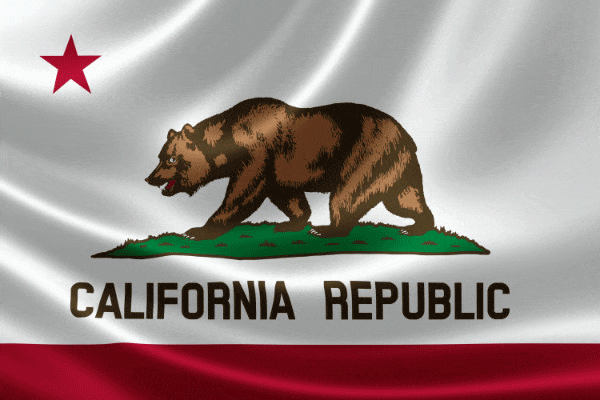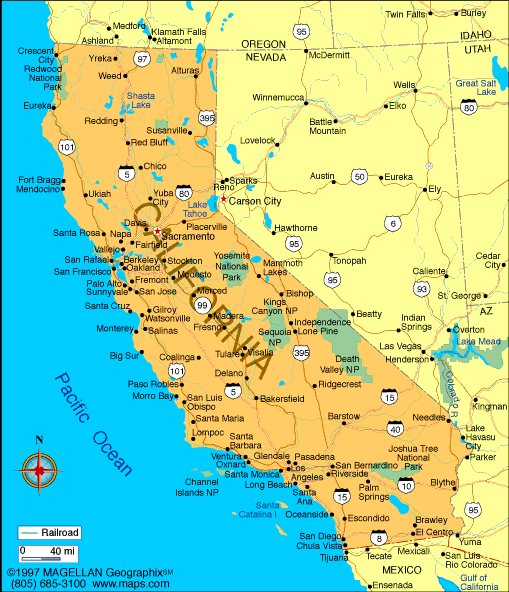

California flag
Capital: Sacramento
State abbreviation/Postal code: Calif./CA
U.S. Representatives: 53
Historical biographies of Congressional members
Entered Union (rank): Sept. 9, 1850 (31)
Present constitution adopted: 1879
Motto: Eureka (I have found it)
State symbols:
flower golden poppy (1903)
tree California redwoods (Sequoia sempervirens & Sequoiadendron giganteum) (1937, 1953)
bird California valley quail (1931)
animal California grizzly bear (1953)
fish California golden trout (1947)
colors blue and gold (1951)
song “I Love You, California†(1951)
Nickname: Golden State
Origin of name: From a book, Las Sergas de Esplandián, by Garcia Ordóñez de Montalvo, c. 1500
10 largest cities (2013): Los Angeles, 3,884,307; San Diego, 1,335,896; San Jose, 998,537; San Francisco, 837,442; Fresno, 509,924; Sacramento, 476,686; Long Beach, 469,428; Oakland, 406,253; Bakersfield, 363,630; Anaheim, 345,012
Land area: 155,959 sq mi. (403,934 sq km)
Geographic center: In Madera Co., 38 mi. E of Madera
Number of counties: 58
Largest county by population and area: Los Angeles, 10,017,068 (2013); San Bernardino, 20,062 sq mi.
National forests: 18
State parks and beaches: 278 (1.5 million ac.)
Residents: Californian
2015 resident population: 39,144,818
Although California was sighted by Spanish navigator Juan RodrÃguez Cabrillo in 1542, its first Spanish mission (at San Diego) was not established until 1769. California became a U.S. territory in 1847 when Mexico surrendered it to John C. Frémont. On Jan. 24, 1848, James W. Marshall discovered gold at Sutter's Mill, starting the California Gold Rush and bringing settlers to the state in large numbers. By 1964, California had surpassed New York to become the most populous state. One reason for this may be that more immigrants settle in California than any other state—more than one-third of the nation's total in 1994. Asians and Pacific Islanders led the influx.
Leading industries include agriculture, manufacturing (transportation equipment, machinery, and electronic equipment), biotechnology, aerospace-defense, and tourism. Principal natural resources include timber, petroleum, cement, and natural gas.
Death Valley, in the southeast, is 282 ft below sea level, the lowest point in the nation. Mt. Whitney (14,491 ft) is the highest point in the contiguous 48 states. Lassen Peak is one of two active U.S. volcanoes outside of Alaska and Hawaii; its last eruptions were recorded in 1917.
Other points of interest include Yosemite National Park, Disneyland, Hollywood, the Golden Gate Bridge, Sequoia National Park, San Simeon State Park, and Point Reyes National Seashore.
Austrian-born bodybuilder-turned-actor Arnold Schwarzenegger became governor of California in 2003 in a special recall election, replacing Gray Davis. Gov. Schwarzenegger was reelected in 2006. Jerry Brown was elected governor of California in 2010, an achievement made more remarkable by the fact that he had already been the state's governor from 1975-83.
Almost twenty years after California passed the "Save Our State" initiative, which denied public, social, educational, and health services to illegal immigrants, Gov. Jerry Brown signed a bill in 2011 giving illegal immigrant college students access to state-funded financial aid, the second half of two-part legislation known as the "Dream Act."

No comments:
Post a Comment